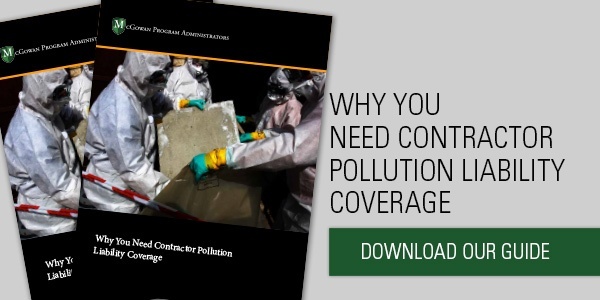Contractors have enough trouble with visible risks — cutting tools, heavy machinery, distracted workers, and so on. Hidden environmental dangers create a whole new category of risk management.
Concealed dangers may be highly specific, like the spread of pathogens in heating ducts, or they can be more general, like a buried fuel tank on a construction site. Some risks can also hide within the macro framework of a project.
Let’s look at all three manifestations of hidden environmental risks for contractors, running from specific to macro issues.
Specific: Ventilation systems
Hidden toxins tend to be microscopic and airborne. Ventilation systems can distribute them to every corner of a building. These are just a few of the contaminants that can spread via heating, ventilation, and air conditioning (HVAC) systems:
- Mold. All mold needs is some moisture and a food source to start infecting a building. Construction work can easily loosen mold spores that soon get distributed via the ductwork. Mold can threaten structural integrity and make people ill, making it one of the most-feared hidden environmental dangers.
- Lead-based paint. Without proper testing of a demolition or refurbishing project, you can’t tell if the paint on old walls has toxic lead content. The dust from old lead paint can become airborne and spread building-wide.
- Legionella. This bacterium infects the lungs of humans, causing severe pneumonia and even death if it’s not caught in time. Legionella typically travels in droplets of airborne moisture and thrives in the stagnant water of air-conditioning cooling towers.
- Asbestos. The tiny fibers of asbestos are common in older buildings and a vast array of industrial sites. Long-term exposure to asbestos causes lung damage and cancer, so any work that accidentally dislodges asbestos and makes it airborne can endanger the health of workers and building occupants.
- Carbon monoxide. The exhaust of burning fuels has a high volume of carbon monoxide, which is odorless, tasteless, invisible — and potentially lethal. Old or malfunctioning heating systems using oil or natural gas can leak carbon monoxide into a building.
HVAC is one of the most likely culprits in distributing hidden toxins. The complexity of these systems only adds to the risk of hidden environmental toxins.
General: Worksites
HVAC-related threats are common enough that they’re easier to anticipate and provision accordingly, but worksites can have an abundance of risks contractors might not think about. A few examples:
- Plumbing and electric. Every time a backhoe operator accidentally breaks a gas line or cuts an electrical cable, many people and businesses depending on those utilities endure damages. Drilling into a water main can be especially expensive.
- Spills and leaks. A forklift can pierce a tank with a thousand gallons of diesel fuel, trigging a messy and expensive cleanup. Careless workers can release toxic gases and fluids, becoming a danger to themselves and anyone nearby.
- Industrial pollutants. Consider the case of polychlorinated biphenyls (PCBs), which have been classified as most likely carcinogenic by the EPA. PCB is a toxic compound that used to be common in electrical machinery and other industrial uses. The sites of former factories, refineries, and other industrial businesses often have lingering PCB contamination that must be tested for and cleaned up. Neglecting this testing can lead to expensive litigation — especially if pollutants sicken or injure people.
The combination of workers, toxins, and their propensity to cause havoc in moments of inattention creates worksite risks you can’t ignore. Unfortunately, you also can’t tell when trouble will erupt.
Macro: Project conception
Projects are typically conceived as design/build or design/bid/build. Each variety has specific risk issues, but to illustrate common challenges, we’ll focus on design/build projects.
With design/build, a project owner hires the same company to do everything from engineering to architecture to construction to completion. There’s a presumption that the design/build company takes on all the liability for a project and shields the owner from potential risks, but this might not always be the case.
Here’s one simple example: The design-build company estimates a new apartment complex will cost $15 million, but missed environmental toxins at the site require a massive cleanup that pushes the company’s costs up to $20 million. If the company cannot raise the extra $5 million, they could be forced to file for bankruptcy and abandon the project in midstream. That would prove costly to the project owner.
Every line of a design/builder’s agreements with its subcontractors must be scrutinized to make sure liability scenarios are covered. In this instance, the missed environmental toxins could be the error of the contractor or the liability of the project owner. In either case, environmental liability coverages could have been utilized in order to mitigate the liability to both the owner and contractor on this project.
The design/builder and subcontractors may agree to exclude coverage of certain liabilities they deem highly unlikely, but if that highly unlikely event causes monetary damages that trigger severe financial setbacks, an entire project could grind to a halt.
Provisioning for environmental risks
Industrial operations and construction projects inevitably raise the risk of injuring people, damaging property, and delaying commercial initiatives. All these outcomes can produce expensive litigation and jury awards.
McGowan Program Administrators helps contractors mitigate these potential risks and liabilities with two kinds of coverage:
- Environmental Contractors Insurance — specifically for companies in the environmental contracting and consulting business
- Contractors Pollution Liability — protects contractors from pollution-damage claims.
Give us a call and let us help you find the right fit for your contracting business.
Related article:



